
With nearly two decades of experience in issue campaign strategy, lobbying, strategic communications, and corporate third-party engagement, Damara Catlett brings a thoughtful and creative approach to her work managing a broad portfolio of clients in tech, media, civil rights, and social justice. Damara was a government affairs principal at the Raben Group for 13 years, leading cutting edge issue campaigns. She worked with Airbnb during the company’s nascent years to build its strategy around domestic lobbying, strategic communications, and partner engagement. She spearheaded efforts for We Must Count, drawing national attention to the disproportionate impact of COVID-19 on communities of color. She helped manage the Second Chance on Shoot First campaign, which brought national awareness to Stand Your Ground laws following the shooting of Trayvon Martin. She led a multi-state civic engagement campaign for the National Urban League that reached over 350,000 African American voters. Damara got her start working as a client strategies manager at Winning Connections, where she managed voter contact campaigns for nonprofits, political party organizations, and candidates, including the Democratic Congressional Campaign Committee. She is a board member of the Voter Participation Center, a member of the National Institute for Lobbying Ethics’s AI Task Force, an advisory board member for the Center for Democracy and Technology, was a New Leaders Council Institute Fellow, and served on the inaugural Kennedy Center Culture Caucus, where she worked with afrofuturists forecasting emerging tech policy issues through the arts.
Damara resides in Washington, D.C. with her fiance. Outside of work you can find Damara running, hiking or camping.

















